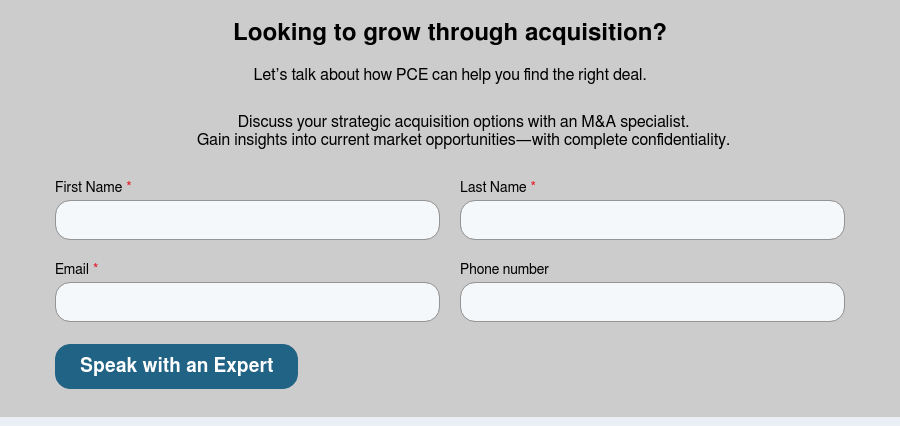Industry Trends
Largest Transactions Closed
- Target
- Buyer
- Value($mm)
As a company leader, you recognize the difficulties of evaluating target companies for potential acquisition—and determining purchase price is particularly challenging. For business owners and financial executives alike, understanding the valuation process is an essential part of making an informed decision. To help you navigate this complex landscape, let's explore the four crucial factors you need to consider when valuing a target, as well as the two main approaches you might use to achieve an accurate valuation.
At first glance, you might think that accurately determining the value of a potential acquisition is impossibly complicated, involving everything from pricing tangible assets to predicting future consumer behavior. But a systematic approach can highlight the right elements and give you the answers you need. When evaluating a target that seems right for your company, you should focus on the following four critical elements to develop a comprehensive view of the target's worth. Learn how to further ensure acquisition success in our guide How to Guarantee the Success of Your M&A Transaction.
Strong financial performance can increase the target's attractiveness to potential buyers like you. Acquirers generally analyze the target's financial statements, looking at revenue growth, profit margins, and cash flow.
Consistent revenue growth indicates that the company is in demand and has adopted a viable, long-term business model, suggesting an ability to sustain itself in the future. A company with healthy profit margins is likely to be efficiently run, with sound operational practices. Higher margins typically reflect stronger profitability, which is a key factor in determining value. Positive, stable cash flow is also essential because it shows that the company can cover its expenses and invest in growth. Because cash flow reflects actual liquidity, it is often a more reliable measure of financial health than profits alone.
Assessing the target company's future value involves evaluating three points in particular: market expansion, availability of new products/services, and scalability.
Is there room for the target company to expand into new geographic regions or untapped markets? Pinpointing easy opportunities for market expansion will suggest that the company is more valuable. Likewise, analyze whether opportunities exist to introduce new products or services to the market. Does the company's pipeline, including any research and development efforts, reveal ways to unlock future revenue streams? Finally, examine whether the company's business model presents a chance for scalability. A company that can scale its operations and grow without significantly increasing costs likely has strong future profitability. But remember, companies with high growth potential may command a premium.
The greater the potential for synergies between your company and the potential acquisition, the more valuable the target company becomes. Look for opportunities to create additional value post-acquisition through cost and revenue synergies. Ensure successful integration by consulting our resource on Executing Your M&A Integration Plan."
Cost synergies occur when you can reduce operational costs for the newly combined company by eliminating redundancies. Merging back-office operations, consolidating suppliers, and optimizing the supply chain are examples of cost synergies that improve your profitability post-acquisition. Revenue synergies can offer ways to increase revenue by cross-selling products, accessing new customer bases, or expanding into new markets—particularly attractive in the eyes of potential buyers because these synergies can deliver top-line growth.
Due diligence helps uncover various risks and liabilities that can significantly impact the company's value and may result in adjustments to the purchase price. To learn more, review our guide on 7 Red Flags in the Acquisition Process.
Legal liabilities include any ongoing or potential lawsuits, intellectual property disputes, or regulatory issues that could pose legal risks for your company post-acquisition. In addition to reviewing for these, assess the target company for operational risks, such as unreliable suppliers, high employee turnover, or compliance issues that could disrupt business activities. Finally, examine the target's financial liabilities, including outstanding debt, unpaid taxes, and unrecorded liabilities.
After focusing on the various factors that may impact the value of a potential target, you will need to examine the company using your chosen appraisal methodology. The most common methodologies are the income approach and the market approach—and you may wish to derive the target's final valuation by averaging the two approaches.
Based on the time value of money principle, which states that a dollar today is worth more than a dollar in the future, the income approach examines the target's anticipated future cash flows and discounts them back to present value. Also known as “discounted cash flow” (DCF), this analysis is significantly influenced by projections of future cash flows, growth rates, discount rates, and terminal values. Because minor adjustments in these parameters can lead to substantial changes in the final valuation, DCF models can be overly sensitive to alterations in assumptions.
Forecasting cash flows over an extended period presents another challenge, particularly if the target company has an unpredictable future or operates in an unstable sector. Furthermore, determining a suitable discount rate—one that accurately represents the risk linked to future cash flows—is essential during a DCF analysis. However, accurately estimating sustainable growth rates or projecting long-term cash flow trends becomes progressively harder the further you look into the future, and effectively quantifying the risk premium or modifying discount rates in response to fluctuating market conditions also poses a significant challenge. For these reasons, valuations derived using the DCF method can be unreliable.
The market approach uses two common methods. The guideline public company approach assesses the value of the target company by examining the comparative valuations of analogous publicly traded firms. First, analyze the trading positions of these stocks as indicators of market valuation for companies within this sector; then, use the trading multiples of these comparable companies to evaluate the target. The guideline transaction approach, on the other hand, determines the target's value by referencing the comparative valuations of similar companies that have been recently acquired. Review the multiples at which these companies were sold as reflections of market pricing for firms in this industry and apply these multiples (or something similar) to your target company.
Unfortunately, it can sometimes be difficult to identify transactions or companies that are comparable; for example, public companies that are much larger than the target may not reflect the correct pricing multiple. And, when using the guideline transaction approach, it can be challenging not only to find data but also to determine its relevance, depending on the availability and quality of the transaction data. Press releases can be useful in identifying transactions involving similar companies, but they may not contain sufficient information to calculate relevant pricing multiples.
Valuing a target company is a complex process that requires you to carefully weigh multiple factors and methodologies as you modify the price you're willing to pay in anticipation of any future payouts post-acquisition. For senior managers and company boards, projections of post-acquisition performance are of critical concern and influence price negotiations. Find out how professional advisors help by reading our article on Leveraging an Investment Banker for Your Acquisition Strategy.
And, if you're looking to sell your company, understanding the elements that drive acquirers' decisions can help you better position your company for a successful sale. To maximize your company's value and navigate the complexities of mergers and acquisitions, consider seeking expert guidance from experienced professionals who can provide tailored strategies for your specific situation.

Daniel Cooper
Daniel Cooper is a Managing Director at PCE and plays a key role in the firm’s valuation practice. He specializes in ESOP valuations and estate planning, advising clients across industries on financial reporting, tax, and transaction-related valuation matters.
Valuation
New York Office
201-425-1671 (direct)
dcooper@pcecompanies.com
Connect
201-425-1671 (direct)
407-621-2199 (fax)
